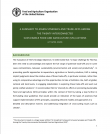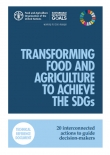مطبوعات

The Evaluation of FAO’s Strategic Objective 2 in 2018 noted that “a major challenge for FAO has been the need to acknowledge and explore the full range of potential trade‐offs and in some cases contradictions, between sustainability (environmental and social) and productivity1. In promoting specific approaches to aquaculture, agriculture or forestry solutions, FAO is making implicit judgments about the relative value of these trade‐offs, in particular contexts, rather than using its comparative advantage and the opportunities to take a facilitator role, both at global, national and local levels, in engaging stakeholders in exploring these trade‐offs and work out jointly crafted solutions”.

الطريق نحو تحقيق الازدهار يتمثل، بشكل واضح، بإنجاز خطة التنمية المستدامة لعام 2030. إنه يتطلب إجراءات تحويلية، تشمل مبادئ الاستدامة ومعالجة الأسباب الجذرية للفقر والجوع لضمان عدم ترك أي أحد متخلفاً عن الركب. وبوصفها العلاقة الأساسية بين الناس والكرة الأرضية، تتمتع الأغذية والزراعة المستدامة بإمكانيات كبيرة للتصدي للعديد من التحديات التي تواجهنا، وتوفير غذاء مغذي وبأسعار معقولة، وتعزيز سبل العيش، وإحياء المناظر الطبيعية الريفية والحضرية، وتحقيق نمو وطني شامل، ودفع عجلة التغيير الإيجابي في جميع أنحاء العالم لتحقيق خطة التنمية المستدامة 2030.
كيف يمكن لصانعي القرار تحويل تلك الإمكانات إلى حقيقة؟ كيف يمكنهم اختيار الموارد وتحديد أولوياتها لتسريع التقدم؟ تقدم هذه المطبوعة حلولاً عملية من خلال 20 إجراءً مترابطاً، كل منها يصف النهج والسياسات والأدوات التي تساهم في العديد من أهداف التنمية المستدامة. فهي تدمج ما بين الأبعاد الثلاثة للتنمية المستدامة، وتتطلب المشاركة والشراكات بين مختلف الجهات الفاعلة. ومن خلال تحديد أوجه التآزر، وفهم المفاضلات، وتحديد الحوافز، تتناول هذه الإجراءات العشرين المشاكل الحقيقية التي تواجهها البلدان في إيجاد عالم خالٍ من الجوع وضمان مستقبل أكثر إشراقاً للجميع.

These guidelines are primarily directed towards decision-makers responsible for integrating the goals and targets of the 2030 Agenda for Sustainable Development into national policies and programmes. They will be of value to public and private actors, including investors, researchers and technical practitioners, involved in the broad area of food and agriculture, and rural development. Complementing FAO’s Common Vision for Sustainable Food and Agriculture and its five principles, this publication presents 20 practical and interconnected actions with the aim of transforming food and agriculture and driving achievement across the Sustainable Development Goals (SDGs).

This case study provides information on Bangladesh's experience in mainstreaming Sustainable Food and Agriculture to achieve the SDGs. It links it to FAO's vision for sustainable food and agriculture and its 5 key principles.

This case study provides information on Colombia's Caribbean region's experience in mainstreaming Sustainable Food and Agriculture to achieve the SDGs. It links it to FAO's vision for sustainable food and agriculture and its 5 key principles.

